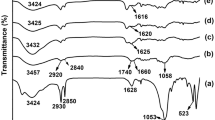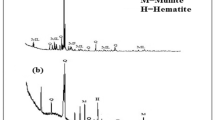Abstract
In present work; epoxidized soybean oil (ESO), fly ash (FA) and natural clay (C) are used to produce 45 kinds of biocomposite materials and by analyzing the physical–mechanical properties of these novel materials, their use as an insulation material is investigated. The compressive strength, tensile strength, abrasion loss, thermal conductivity and oven-dry mass of each sample are measured. The minimum thermal conductivity of 0.273 W/mK is observed with the samples containing ESO–FA–C. It is increased with the decrease of ESO and FA. The compressive and tensile strengths are varied from 13.53 to 6.31 MPa and 1.287 to 0.879 MPa, respectively.








Similar content being viewed by others
Abbreviations
- ESO:
-
Epoxidized soybean oil
- SO:
-
Soybean oil
- FA:
-
Fly ash
- K :
-
Constant of Shoterm QTM apparatus
- H :
-
Constant of Shoterm QTM apparatus
- t 1 :
-
Temperature of startup (K)
- t 2 :
-
Temperature of finish (K)
- V 1 :
-
The startup voltages of thermoelement (mV)
- V 2 :
-
The finish voltages of thermoelement (mV)
- k :
-
Thermal conductivity coefficient (W/mK)
- T avr :
-
Average temperature (K)
- I :
-
Current density in heater wire (A)
References
E.H. Pryde, Handbook of Soy Oil Processing and Utilization (American Oil Chemists Society, Champaign, IL, 1990)
C.S. Nevin, B.F. Moser, Vinyl oil monomers. I. Vicinal methacryloxy–hydroxy soy oils. J. Appl. Polym. Sci. 7, 1853–1866 (1963)
F. Mustata, Rheological and thermal behaviour of an epoxy resin modified with reactive diluents. J. Polym. Eng. 17, 491–506 (1997)
F.S. Güner, Y. Yağcı, A.T. Erciyes, Polymers from triglyceride oils. Prog. Polym. Sci. 31, 633–670 (2006)
S.N. Khot, J.J. Lascala, E. Can, S.S. Morye, G.I. Williams, G.R. Palmese, Development and application of triglyceride-based polymers and composites. J. Appl. Polym. Sci. 82(3), 703–723 (2001)
V. Sharma, P.P. Kundu, Addition polymers from natural oils—a review. Prog. Polym. Sci. 31, 983–1008 (2006)
F.D. Gunstone, Chemistry and Biochemistry of Fatty Acids and Their Glycerides (Chapman and Hall, London, 1967)
A.B. Strong, Molecular design advances in resin chemistry, in Compos Fabrication (1998), pp. 1218–1224
I. Frischinger, S. Dirlikov, Two-phase epoxy thermosets that contain epoxidized triglyceride oils. Polym. Mat. Sci. Eng. 69, 390–391 (1993)
S. Dirlikov, I. Frischinger, Z. Chen, Phase separation of two-phase epoxy thermosets that contain epoxidized triglyceride oils, in Toughened Plastics II: Novel Approaches in Science and Engineering, Advances in Chemistry Series, vol. 252 (1996), p. 95
H. Warth, R. Mulhaupt, B. Hoffman, S. Lawson, Polyester networks based upon epoxidized and maleinated natural oils. Angew. Makromol. Chem. 79, 249 (1997)
J.V. Crivello, R. Narayan, Epoxidized triglycerides as renewable monomers in photoinitiated cationic polymerization. Chem. Mater. 4, 692 (1992)
F. Gunstone, Fatty Acid & Lipid Chemistry (Blackie Academic & Professional, New York, 1996)
C.G. Force, F.S. Star, Vegetable oil adducts as emollients in skin and hair care products, US Patent 4740367 (4), 1988, p. 367
S.V. Vassileva, C.G. Vassilevaa, A.I. Karayigit, Y. Bulut, A. Alastueyc, X. Querolc, Phase mineral and chemical composition of composite samples from feed coals, bottom ashes and fly ashes at the Soma power station. Int. J. Coal Geol. Turkey 61, 35–63 (2005)
V. Tiwari, A. Shukla, A. Bose, Acoustic properties of cenosphere reinforced cement and asphalt concrete. Appl. Acoust. 65, 263–275 (2004)
R.K.Y. Li, J.Z. Liang, S.C. Tjong, Morphology and dynamic mechanical properties of glass beads filled low density polyethylene composites. Mater. Process. Technol. 79, 59–65 (1998)
M. Singh, M. Garg, Cementitious binder from fly ash and other industrial wastes. Cem. Concr. Res. 29, 309–314 (1999)
Z. Liu, S.Z. Erhan, J. Xu, Preparation, characterization and mechanical properties of epoxidized soybean oil/clay nanocomposites. Polymer 46, 10119–10127 (2005)
E. Murad, T. Wagner, The firing process. Hyperfine interactions. Clay Clay Miner. 117, 337–356 (1998)
D. Alkaya, G. İmançlı, Uçucu Kül katkısının Dolgu zeminlerin stabilitesine Etkisi ve Uçucu Küllerin Zemin İyileştirmede Kullanılması, Pamukkale Üniversitesi, Proje No: 2001FBE036 Denizli (2002)
S. Denko, Shotherm Operation Manual No: 125-2.K.K. Instrument Products Department, 13-9 Shiba Daimon, Tokyo 105, Japan
Y. Biçer, Termik Santral Uçucu Küllerinin Değişik Bağlayıcı Kombinasyonlarda Isı İletim Özelliklerinin Analizi ve Değerlendirilmesi. Doktora Tezi. FÜ Fen Bilimleri Enstitüsü, Elazığ, 1990
L. Mbumbia, A.M. De Wilmars, J. Tirlocq, Performance characteristics of lateritic soil bricks fired at low temperatures: a case study of Cameroon. Constr. Build Mater. 14, 121–131 (2000)
W.J. McBurney, The effect of strength of brick on compressive strength of brick masonry. Process ASTM (Part II) 28 (1970)
G.C.J. Lynch, Brick: properties and classifications. Struct. Survey 12(4), 15–20 (1993)
R. Siddique, Effect of fine aggregate replacement with Class F fly ash on the abrasion resistance of concrete. Cem. Concr Res. 33(11), 1877–1881 (2003)
E. Horszczaruk, Abrasion resistance of high-strength concrete in hydraulic structures. Wear 259(1), 62–69 (2005)
I. Yüksel, Ö. Özkan, T. Bilir, Use of granulated blast-furnace slag in concrete as fine aggregate. ACI Mater. J. 103(3), 203–208 (2006)
Acknowledgement
The authors gratefully acknowledge the financial support from the Scientific Research Projects Administration Unit of Firat University (Elazığ, Turkey) for this study (project number: 1245).
Author information
Authors and Affiliations
Corresponding author
Rights and permissions
About this article
Cite this article
Balo, F., Yucel, H.L. & Ucar, A. Physical and mechanical properties of materials prepared using Class C fly ash and soybean oil. J Porous Mater 17, 553–564 (2010). https://doi.org/10.1007/s10934-009-9324-1
Received:
Accepted:
Published:
Issue Date:
DOI: https://doi.org/10.1007/s10934-009-9324-1




